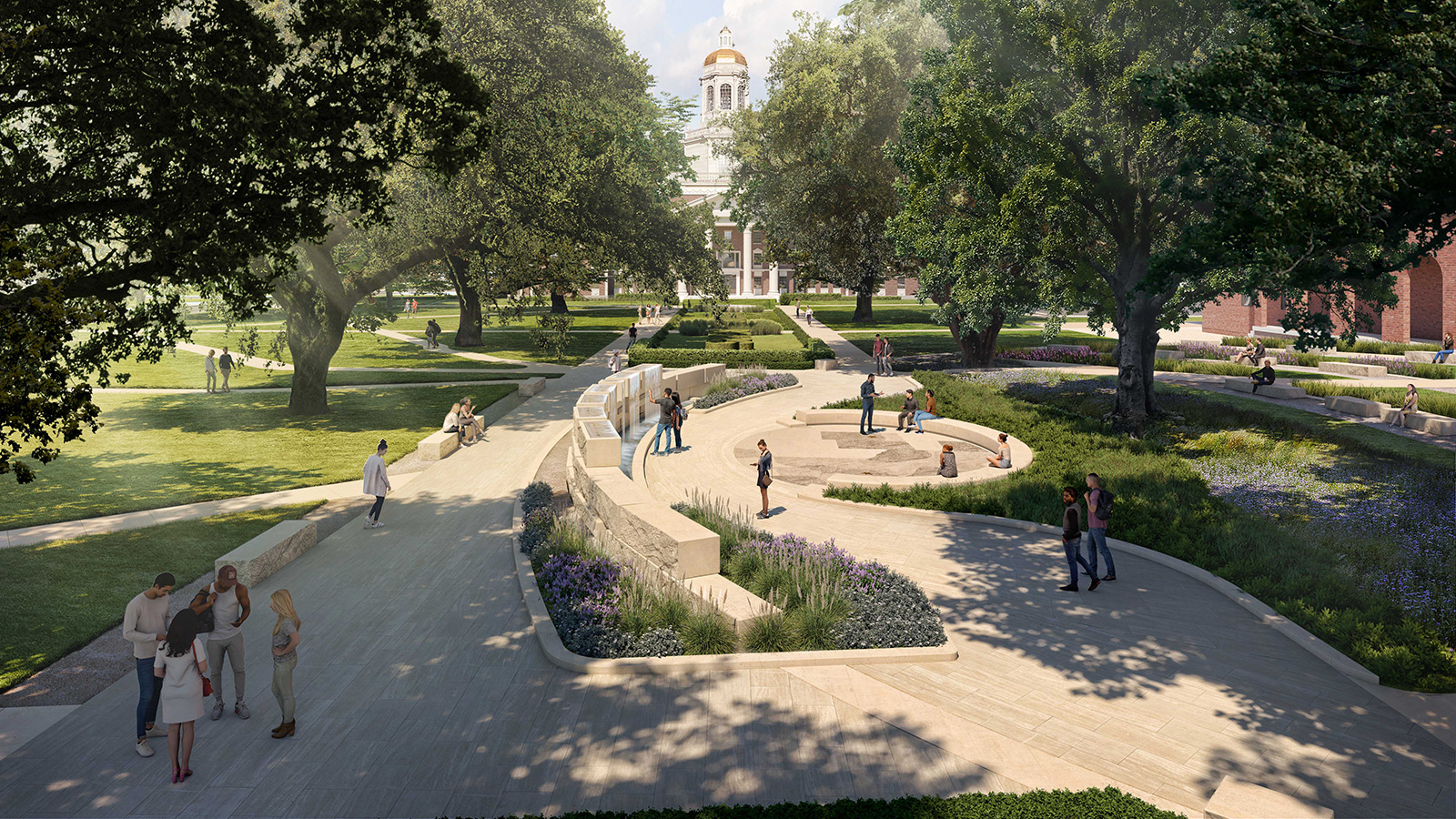Ceremonial Groundbreaking of Memorial to Enslaved Persons Highlights Baylor Board of Regents Meeting
Contact: Lori Fogleman, Baylor University Media and Public Relations, 254-709-5959
Follow us on X (Twitter): @BaylorUMedia
WACO, Texas (Feb. 23, 2024) – Gathering on Baylor University’s historic Founders Mall alongside members of the University and Waco communities, the Baylor Board of Regents concluded its regular quarterly meeting today with a ceremonial groundbreaking of the Memorial to Enslaved Persons. One of the recommendations in the final report from the University’s Commission on Historic Campus Representations – which was unanimously accepted by the Regents in February 2021 – the Memorial will recognize the enslaved men, women and children who were instrumental in building Baylor’s original campus in Independence, Texas.
In May 2022, Regents approved a four-phase framework to address strategic priorities identified by the Commission. Phase 1 is complete, with renowned architectural design firm Sasaki having been selected for the new Campus Experience Project. Phase 2 is underway with today’s groundbreaking and the additional historical context to be placed around the existing Judge R.E.B. Baylor statue in the near future.
“When Baylor was founded in 1845, chattel slavery was deeply woven into the cultural and economic fabric of the state of Texas. Our three primary founders – including our namesake Judge Baylor – were both religious leaders and slaveholders,” Baylor President Linda A. Livingstone, Ph.D., said. “We believe the incompatibility of Baylor’s Christian mission and its roots in chattel slavery requires a collective reckoning with this legacy, and the additional context around Judge Baylor’s statue will connect his story to the enslaved persons being recognized through the Memorial.”
Designed by Sasaki with input from the Campus Experience Project Team and student representatives, the Memorial will create new areas of reflection, gathering and community on Founders Mall. Its key features include:
- A cascading water feature constructed of the same limestone used to build the University’s original campus in Independence;
- Foundational scriptures intended to remind visitors of the freedom all men and women have in Christ now and should have experienced when Baylor was founded in 1845;
- A population density map inlayed in the ground in front of the Memorial depicting the number of enslaved individuals in the counties where Baylor was, circa 1860, and is located; and
- A new Resonance Garden – to complement the iconic Sadie Jo Black Gardens and the Joy Reynolds Rose Gardens – for individual and collective reflection.
Since construction on the Memorial will not begin until after Baylor’s May commencement, the ceremonial groundbreaking included a “turning of the dirt,” using soil from Independence that will later be incorporated into the project
Participants in the ceremony were Board of Regents Chair William E. Mearse, B.B.A. ’78, M.B.A. ’79, President Livingstone, Regent and Commission Co-Chair Alicia D. H. Monroe, M.D., Regent and Commission Member Michael McFarland, B.B.A. ’93, Ed.D. ’05, and Commission Member Rev. Dr. Malcolm Foley, Ph.D. ’21. Commission Member Alan Lefever, B.A. ’84, Ph.D., director of the Texas Baptist Historical Collection, provided context on the significance of the Memorial given the University’s historic Baptist roots.
In her remarks, President Livingstone recognized that both the current and original Baylor campuses are on land originally occupied by Indigenous peoples. While continuing to build relationships, the University plans to tell a more complete story along Speight Avenue of Baylor’s history with Native Nations, Indigenous communities and other groups.
The Memorial to Enslaved Persons recognizes individuals, known and unknown, who were instrumental in building Baylor’s original campus in Independence, Texas. It features an arced Outer Ring and a ground level Inner Ring that is 88 feet in circumference. The Inner Ring tells the story of slavery in Texas and nationally around the time of Baylor’s founding. This view is from the Judge Baylor statue, facing Pat Neff Hall. (Rendering courtesy of Sasaki)
The arced Outer Ring – the Memorial’s focal point – is nearly 100 feet long and six feet high at its tallest point. There are seven separate water sheets atop the Outer Ring with 1,800 gallons of water per minute flowing across them at any given time. This view is from Pat Neff Hall, facing the Judge Baylor statue. (Rendering courtesy of Sasaki)
The amphitheater-style Resonance Garden is designed to amplify the sound – or the silence – echoing from the Memorial. It will be a place for events, activities and even classes, and it complements the existing Sadie Jo Black Gardens and the Joy Reynolds Rose Gardens. This view faces the Memorial from behind the Resonance Garden. (Rendering courtesy of Sasaki)
There are 33 illuminated voids in the Outer Ring of the Memorial, symbolizing the 33 individuals enslaved by Judge R.E.B. Baylor. The voids are different sizes, representing the different ages of the individuals. This view is from behind the Outer Ring, facing the new Resonance Garden and the Draper Academic Building in the evening. (Rendering courtesy of Sasaki)



